
Choir and guest instrumentalists support the celebration of the 20th anniversary of Rev. Brian Peake's pastorate (June 24, 2022).
Our Stained Glass Windows
The history of stained glass is complex and lengthy. It has been used for thousands of years, beginning with the ancient Romans and Egyptians, who produced small objects made from colored glass. Stained glass windows in Britain can be traced back to the 7th century with some early examples found in churches and monasteries. It appears, though, that the art of stained glass window-making for churches and cathedrals began in earnest in the eleventh century in France and England.
Stained glass windows are composed of hundreds and even thousands of small pieces of colored jeweled glass, connected by lead and cement joints which are so well constructed that they can last for centuries, as many of the great churches of Europe have demonstrated. Color is achieved by adding metal oxides or metal powders to molten glass. Each window is built up into a mosaic of colors fused into the glass while it is still molten. The craftsman follows a design that has been created by an artist. The result: an artistic expression of beauty that establishes a worshipful setting.
Beauty, however, was not and still is not the sole purpose of stained glass windows in churches. In the Middle Ages, this form of art was a means of instruction in a time when few people could read and the written word of God was scarcely available even to those who could read.
The windows of Mayesville Presbyterian Church were created and installed by Willet Studios of Philadelphia in 1977 as the present church building neared completion. The new building was erected to replace the original 1892 church building that had been lost to fire in 1975 when lightning struck the bell tower. The windows were donated by families of the church in memory of loved ones.
The windows are characterized by bold colors, detailed storytelling, and the exquisite craftsmanship that comes from the company’s 127-year-old legacy of stained glass design and restoration. Of a total of nineteen windows, nine are located in the sanctuary. The remaining ten are in various locations near the sanctuary.
The sanctuary windows consist of a large chancel window and eight aisle windows. The four west aisle windows depict key events or figures in Old Testament history that point toward the incarnation of Christ. The chancel window - or "Christ Window" - presents the Incarnation and other significant events in the earthly life of Christ. These depictions lead to the east aisle windows which recall events in the life of the early Church that propelled the great mission to spread the good news of the Gospel to the ends of the earth.
Each of the aisle windows has a large upper medallion in a rich red or deep blue color. This medallion portrays the primary message of the window. A smaller medallion in the lower panel conveys a secondary message.
After nearly 50 years, these windows continue to tell the story of the foundation of the Christian Church and of the events that led to the coming of the long-awaited Messiah in the person of Jesus, He who brought the promise of salvation for all who believe.
Willet Stained Glass began in 1898 when William and Anne Lee Willet founded their stained glass and decorating company in Pittsburgh, Pennsylvania. In 1977, the company merged with James Hauser’s glass company (Hauser Art Glass Company, est. 1946) in Winona, Minnesota, creating one of the world’s largest stained glass studios. After 37 years and thousands of stunning works, the Phillips family purchased the company in 2014, bringing renewed energy to its legacy. In 2023, 125 years after its founding, Aspen Mountain Partners returned the company to its original name—Willet Stained Glass Studios.
Today, the company is one of the largest glass studios in the world, specializing in restoration, repair, and new creations. It has studios in Winona, Minnesota; Cincinnati, Ohio; South Salt Lake, Utah; and Maidens, VA. Over its 127 year history, Willet has designed more than 85,000 windows for 36,000+ churches and institutions all over the world. Its windows grace churches and historic buildings across all 50 states and 14 countries, including landmarks like the National Cathedral in Washington, D.C., Grace Cathedral in San Francisco, the National Presbyterian Church in Washington, D.C., and the Church Center for the United Nations in New York City.
The windows pictured below are those that are located in the sanctuary.
The west aisle windows depict Old Testament events that are key to salvation history.
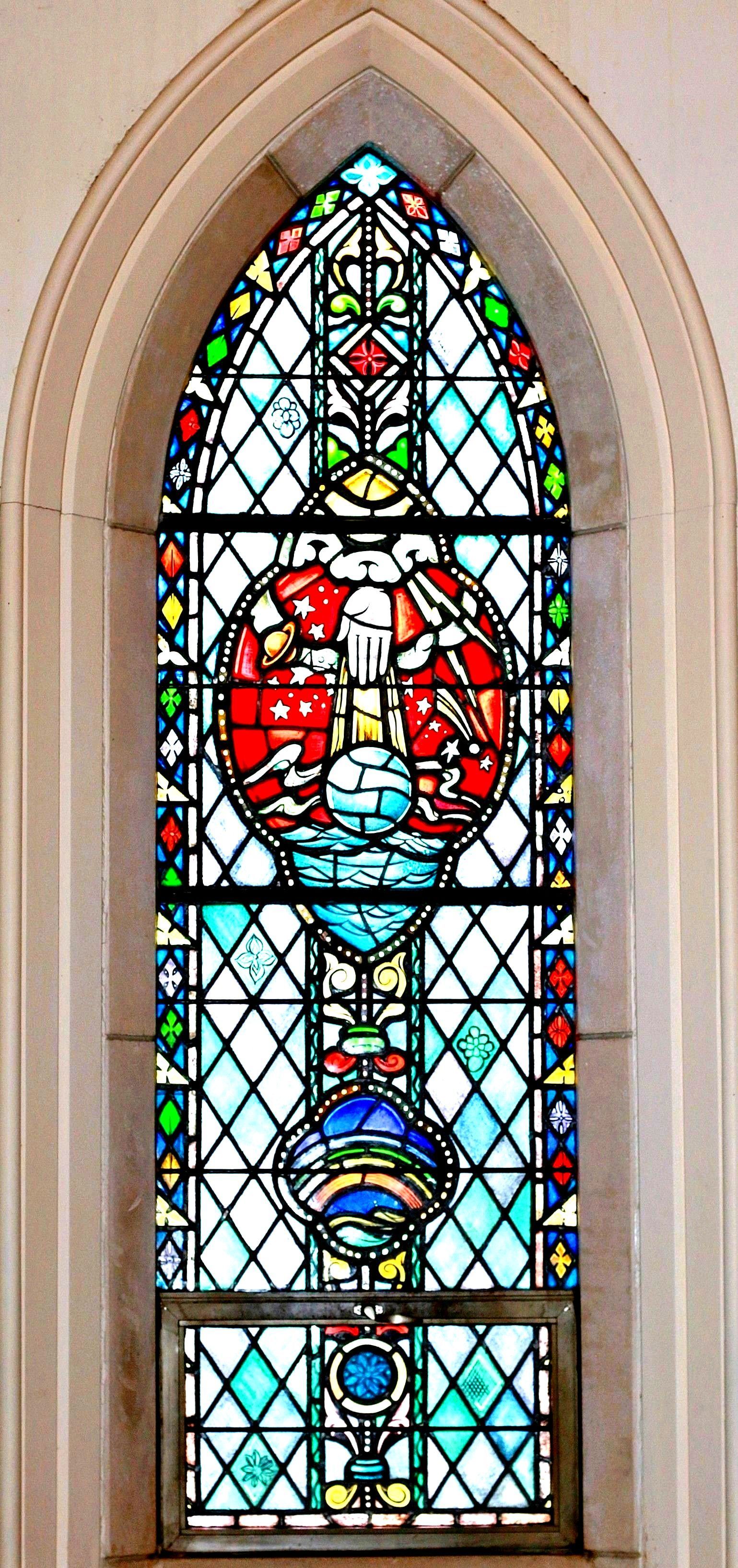
The Creation Window
In the upper medallion, notice the hand of God reaching down from the midst of the heavens, giving the earth form and separating it from the waters. Pictured in the lower medallion is the rainbow, the sign of God’s covenant with Noah that never again would the earth be destroyed by a flood.
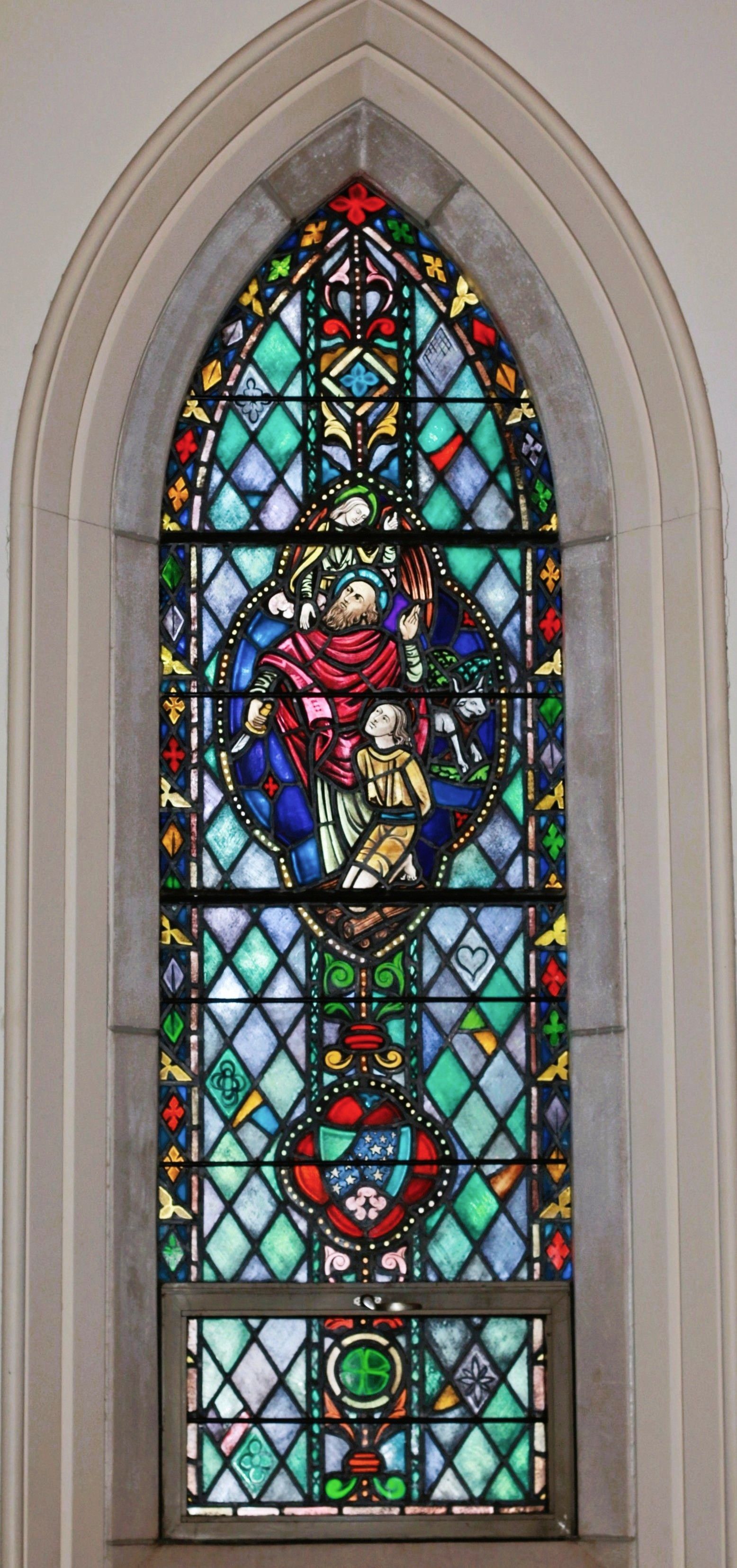
The Abraham Window
The upper medallion depicts the near sacrifice of Abraham’s son, Isaac, as Abraham acted in accord with God’s command. The lower medallion presents a shield with many stars, representing God’s promise to Abraham “to multiply his seed until they are as numerous as the stars.”

The David Window
In the large medallion, David is pictured as a shepherd, playing a harp. The small crown in the background is symbolic of his place in history as a king of Israel. The symbols in the smaller medallion refer to the prophet Isaiah who, like David, was to play a prominent part in the ongoing history of Israel. The tongs hold a burning coal which touched the lips of Isaiah, purifying him as a prophet. The saw is Isaiah’s traditional symbol and is believed to have been the instrument of his martyrdom.
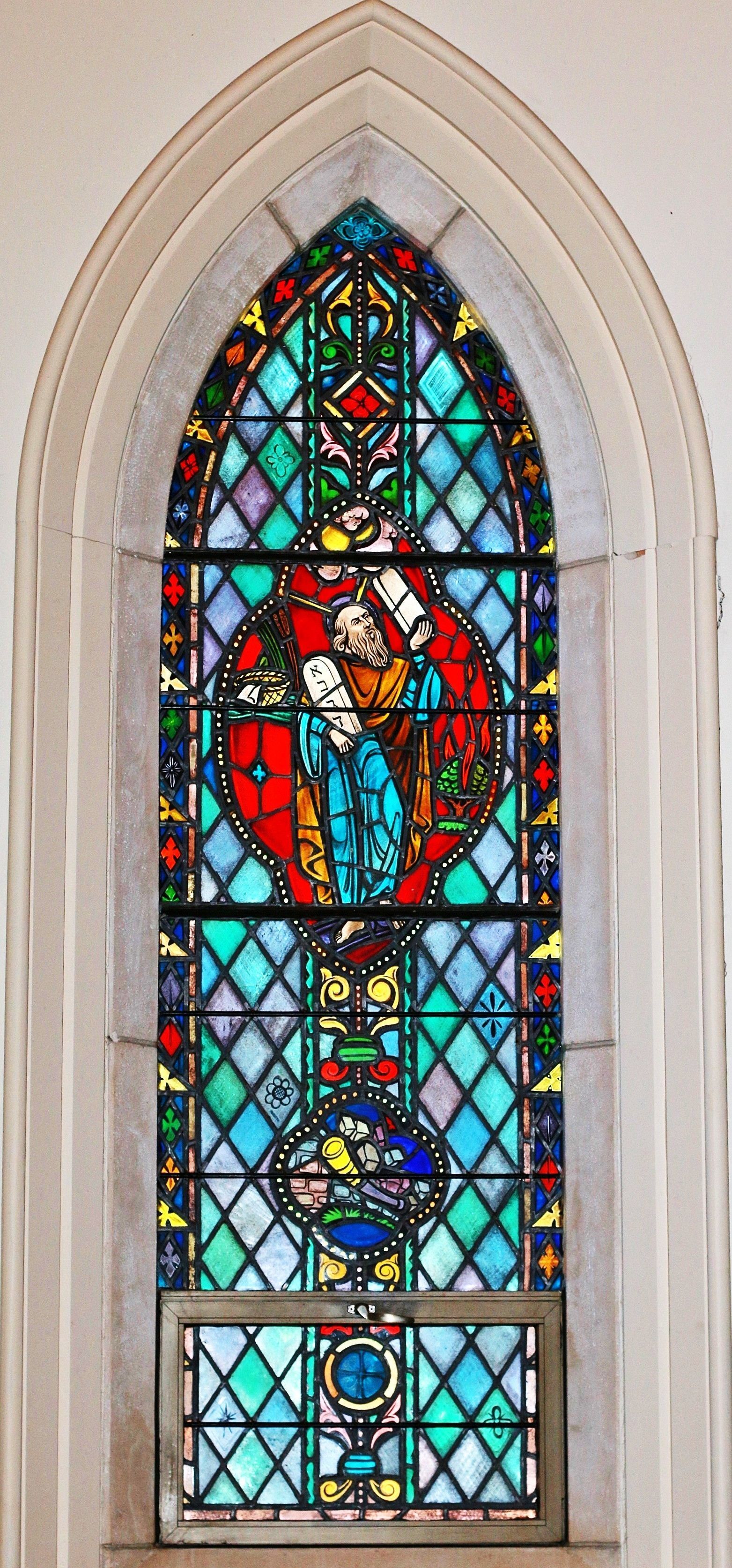
The Moses Window
The tablets of the Law are the focus of the larger medallion, but one can see at the upper left the basket floating among the reeds where baby Moses’ mother placed him in order to save his life. On the right is the burning bush from which came the voice of God. The small medallion at the bottom recalls the blowing of Joshua’s trumpet until the walls of Jericho came tumbling down—a reminder that Moses’ mission was ultimately successful.
The east aisle windows recall significant moments in the early Christian Church that propelled the mission to spread the Gospel to the ends of the earth.
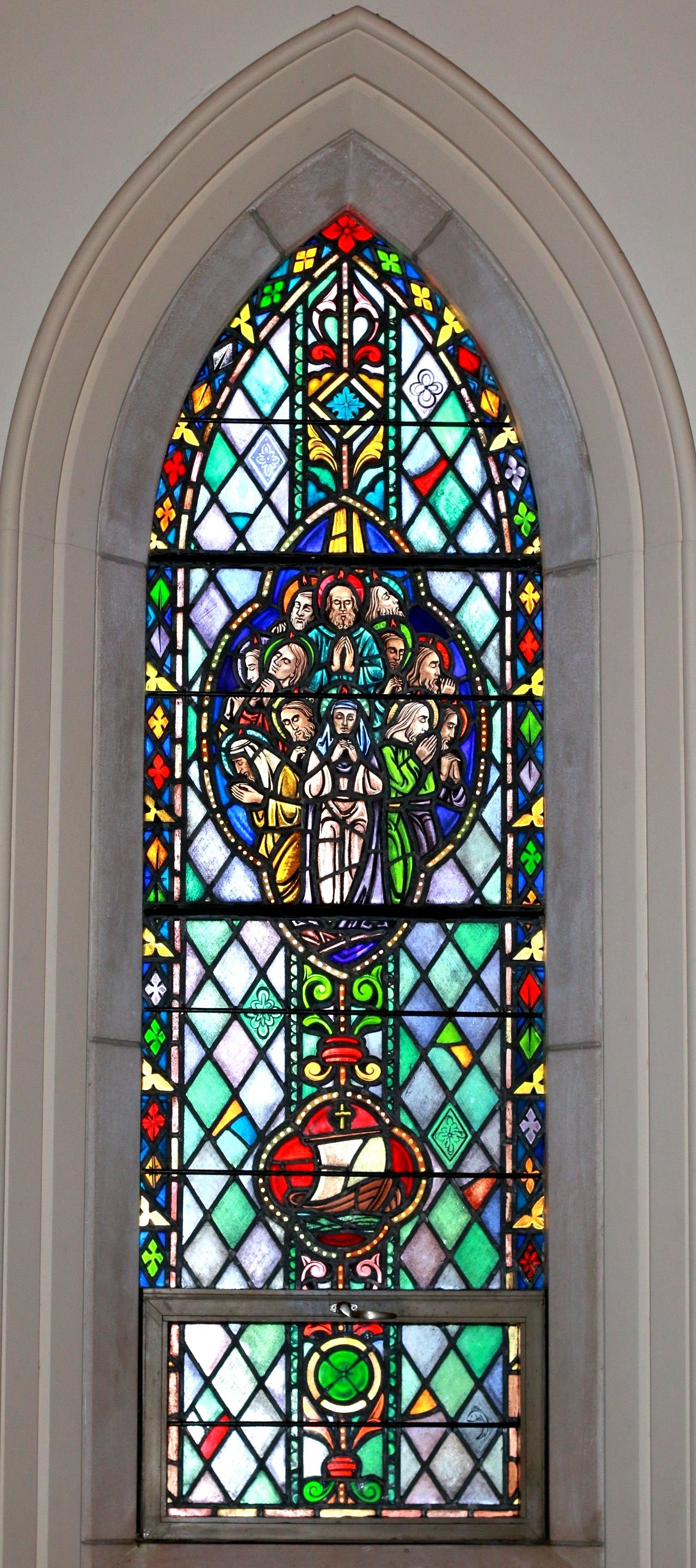
The Pentecost Window
The upper medallion recalls the faithful gathered in the Upper Room to await the coming of the Holy Spirit, as Jesus had instructed them. The lower medallion presents a ship, a long-standing symbol of the Church. The idea is that the wind of the Spirit would propel the ship to the farthest reaches of the earth, spreading the Gospel of Christ. This was the mission of the Church. Notice the ship’s mast in the form of a cross.
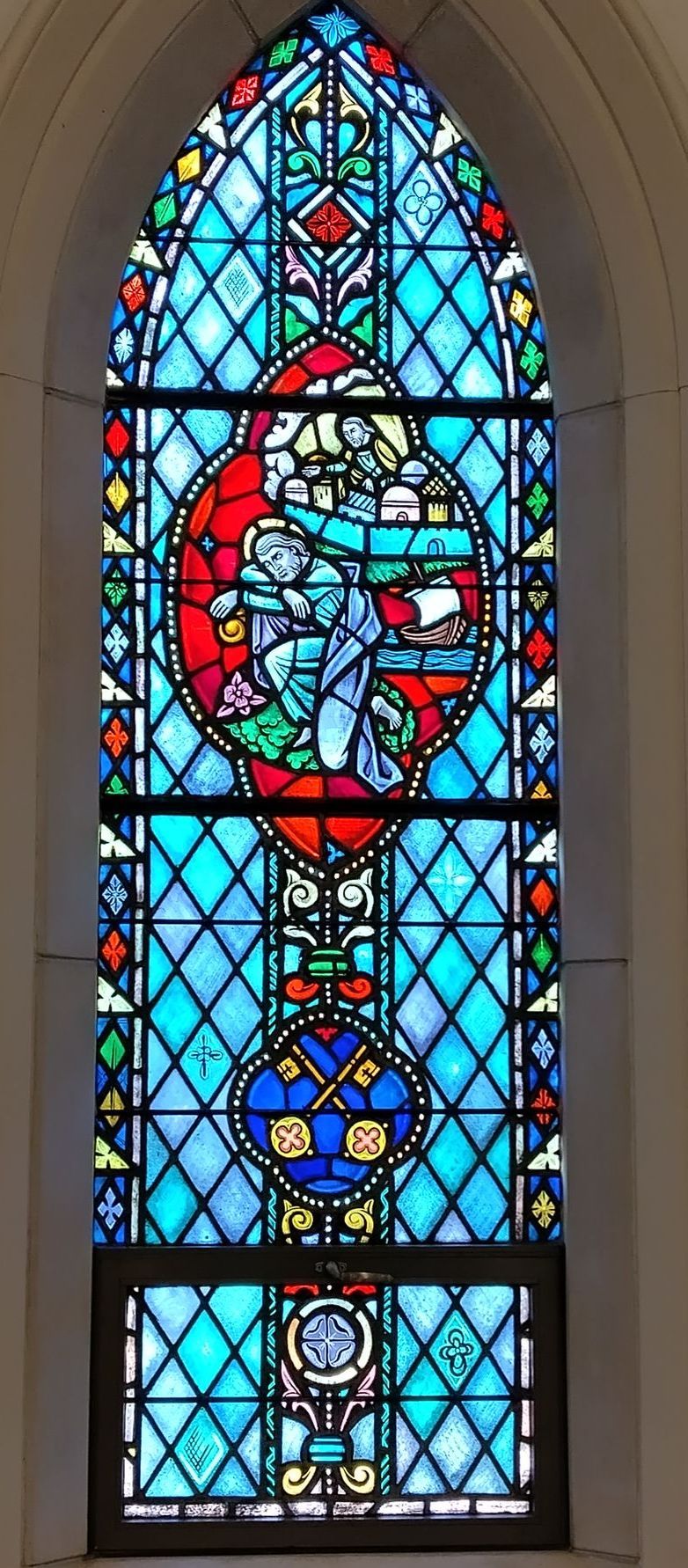
The Cornelius Window
This window depicts Peter’s vision on the housetop with Cornelius. Cornelius is pictured just above a sleeping Peter. The lower medallion pictures two keys, the traditional symbol for Peter.
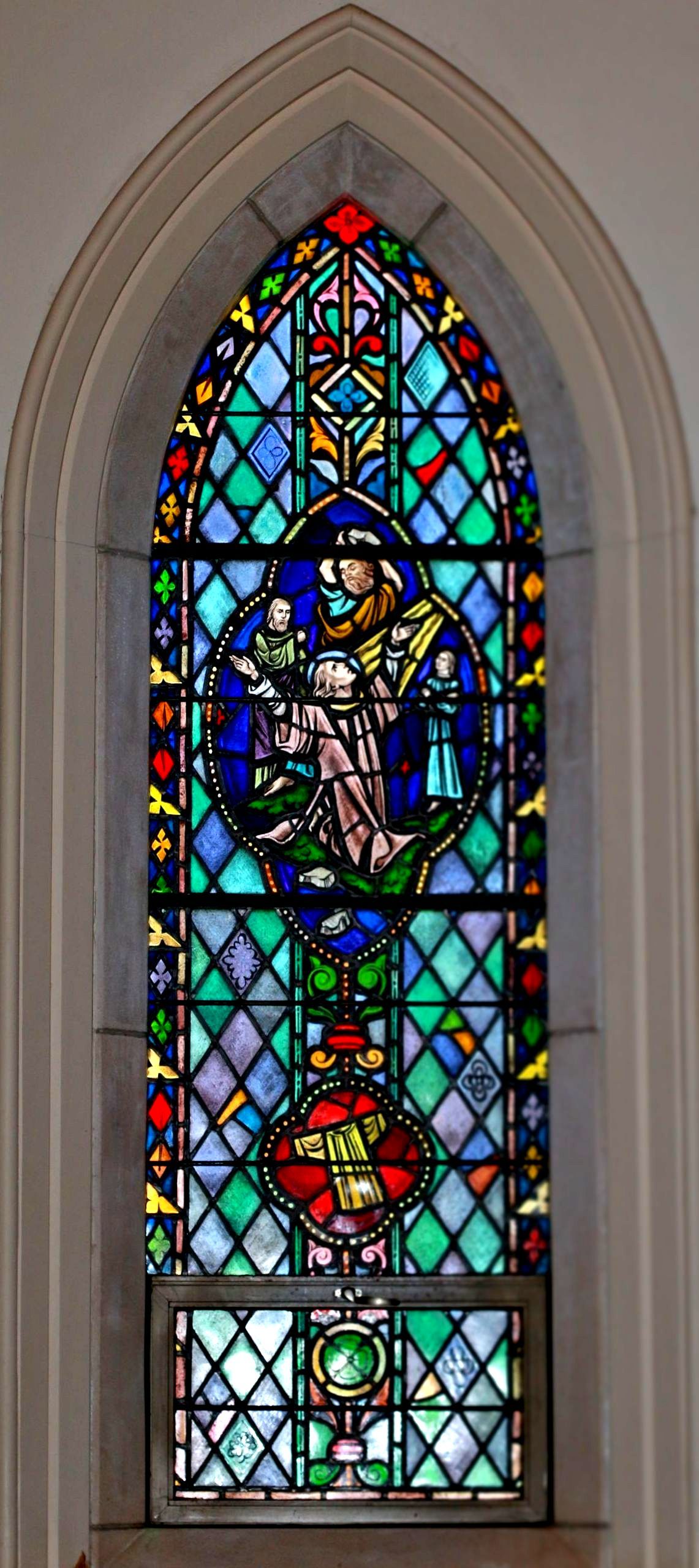
The Stephen Window
The stoning of Stephen is portrayed in the upper medallion. Also represented is Stephen’s vision of Christ standing, waiting to receive him into His presence. The figure pictured nearby, arms folded and giving approval to this terrible event, is Saul. Saul was the leading persecutor of the Christians at that time. The garment in the lower medallion is a “dalmatic,” the traditional garment worn by the deacons of that time. Stephen was among the first group of followers chosen to serve the early Church in a role that foreshadowed the office of deacon.
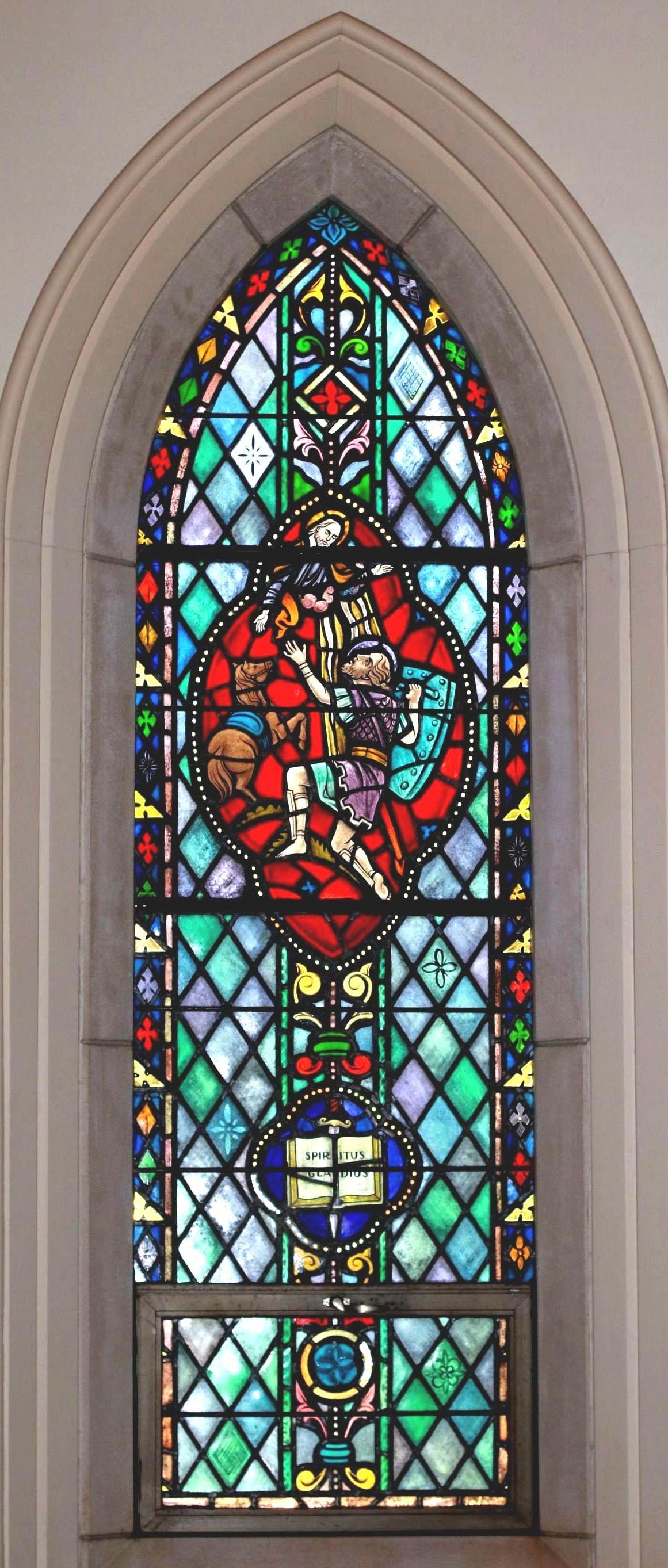
The Saul Window
The upper medallion portrays several elements of this familiar story: the horse, its startled stance reflecting the tremendous light that shone down; the confrontation of Saul by the living Christ, looking down from heaven; and Saul falling to the ground, blinded, with his shield and sword still on him. In the lower medallion is Paul’s symbol – the open book and sword of the Spirit.
The chancel window - or "Christ Window" - depicts significant events in the earthly life of Christ.
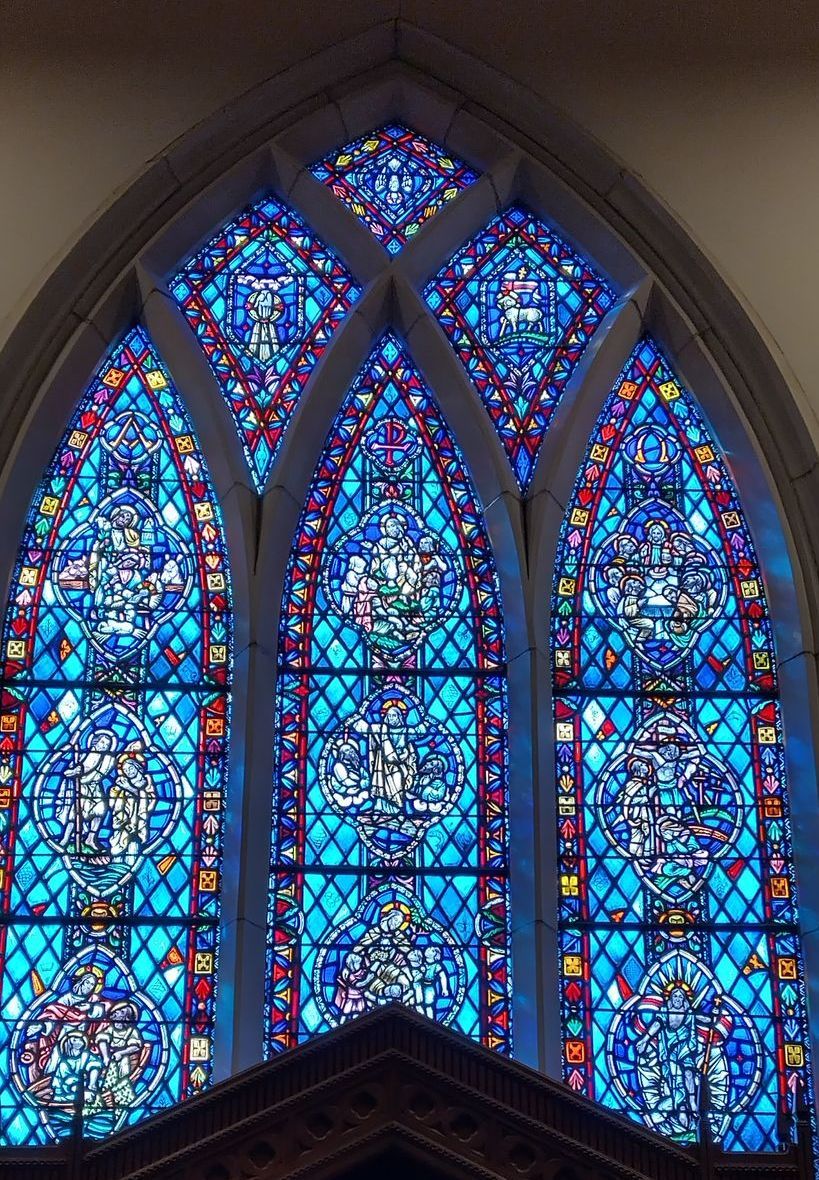
The Chancel Window
This window - also called the Christ window - illustrates key events in the earthly life of Christ. The main segments of the window are shown in close-up and described below.
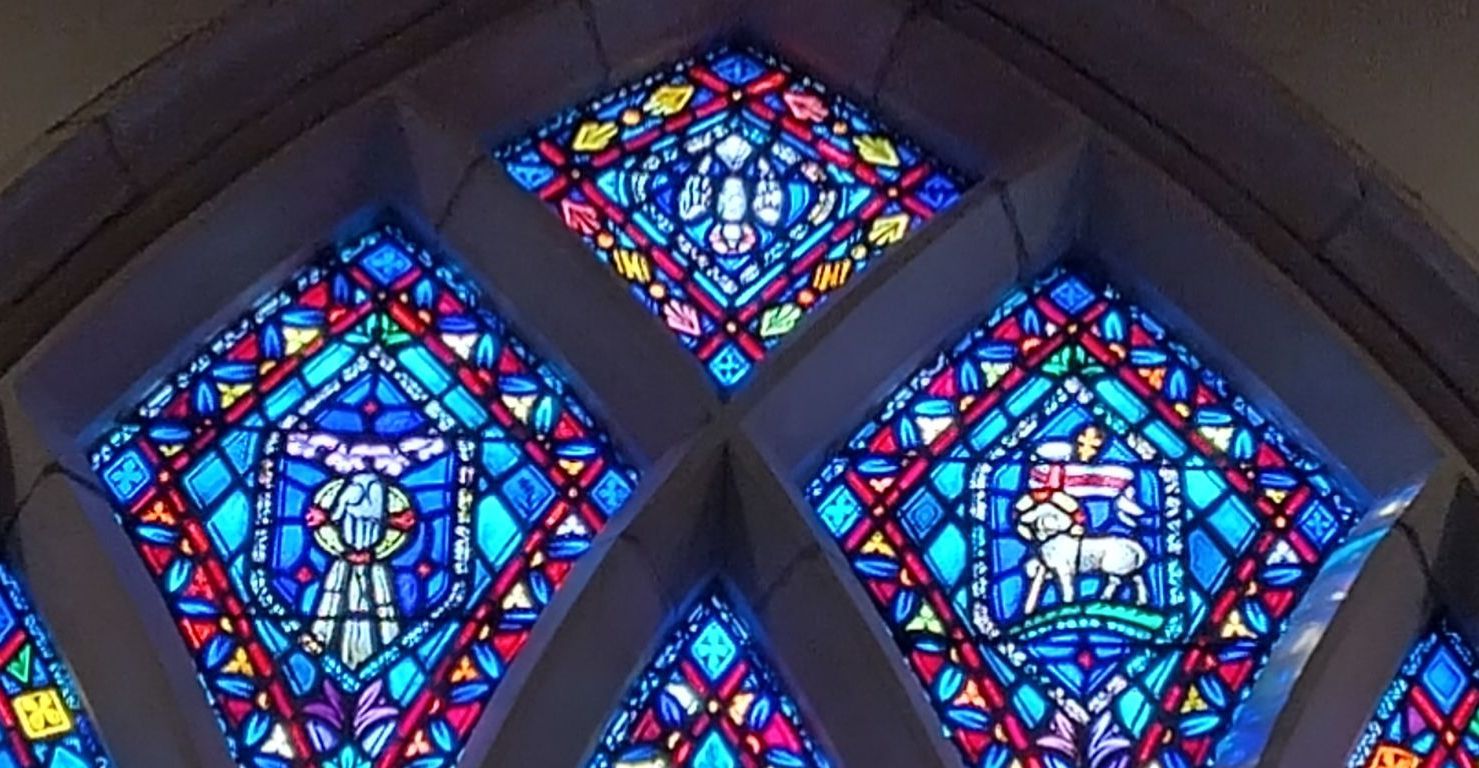
Chancel Window: Top Traceries
The top traceries are symbols of the Trinity. On the left is the hand of God, as in the creation of the world. In the center tracery is the descending dove of the Holy Spirit. On the right is the Lamb of God, John the Baptist’s name for Jesus, who would be sacrificed for the sins of the world.
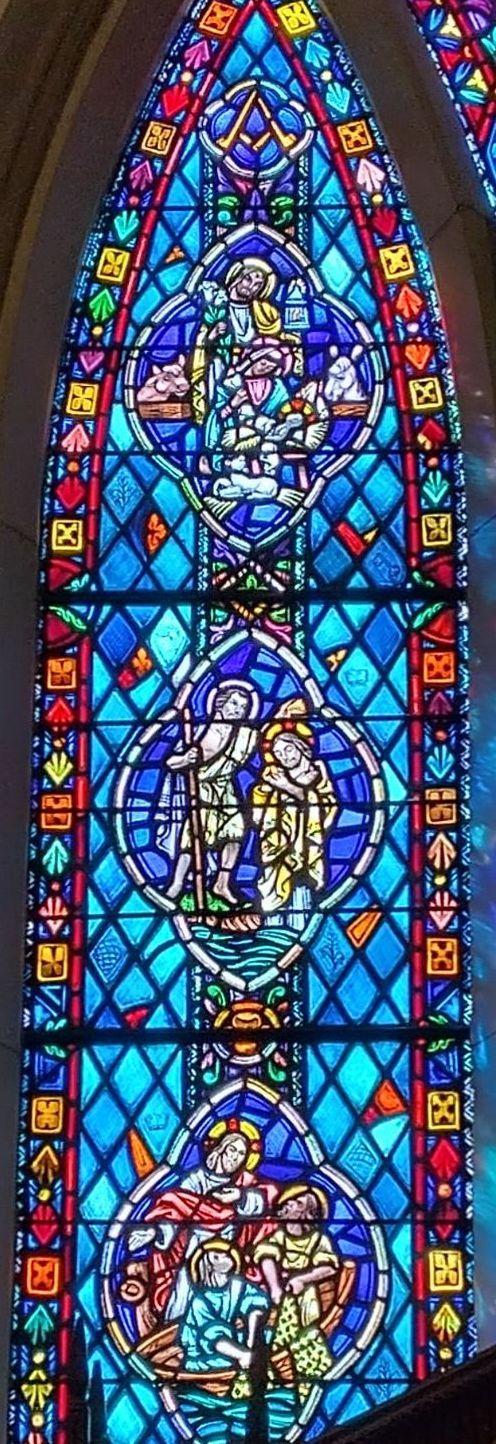
The Chancel Window: Left Lancet
Facing the window, one can see the Nativity scene at the top of the left lancet. The Holy Family is together in the stable with the animals, and Joseph holds a lantern for Him who is the Light of the World. Portrayed below this is Jesus’ baptism by John in the Jordan River. At the bottom of this lancet is pictured the familiar call of the first disciples, who left their boats to become “fishers of men.”
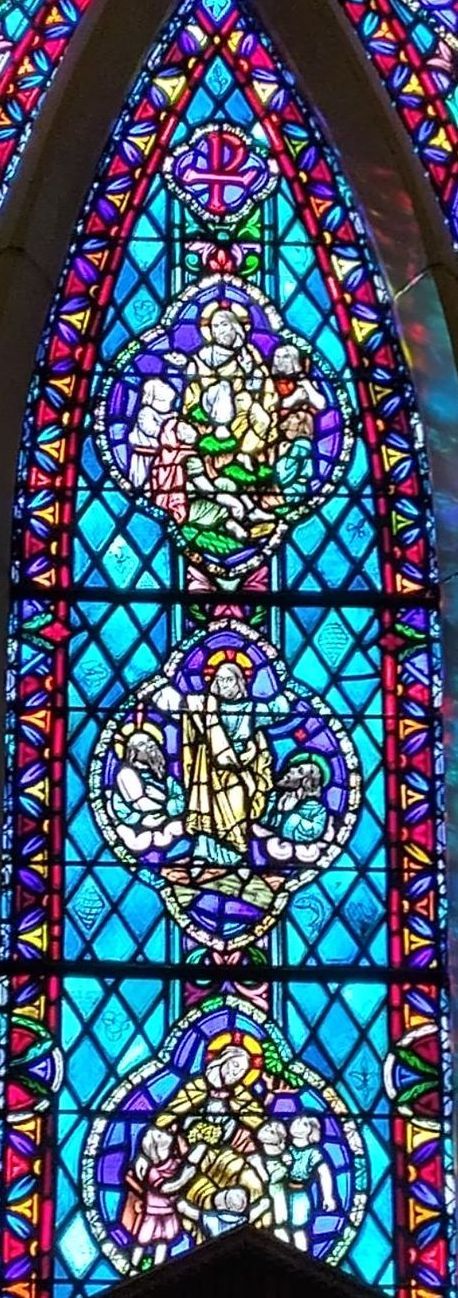
The Chancel Window: Center Lancet
The first scene pictured on the center lancet is the Sermon on the Mount. Next is the Transfiguration. The two persons pictured with Jesus are Moses and Elijah, who represent the law and the prophets. The scene at the bottom portrays Jesus blessing children. This significant part of His ministry stressed the worth of all persons. He taught that unless one “became as a little child,” teachable and trusting, “he could not enter into the Kingdom of God.”

The Chancel Window: Right Lancet
The top medallion depicts the Last Supper. Judas, the traitor, sits at the foot of the table holding the money bag with a tight grasp as he looks away from Jesus. In the center is the crucifixion, the crosses of the two thieves in the background. John, the beloved disciple, and Mary, Jesus’ mother, are weeping at the foot of the cross. Lastly, Christ bursts out of the tomb in triumph. With Him is the traditional figure of the Lamb of God carrying the resurrection banner, symbolizing that the atoning work of Christ has ended in victory.